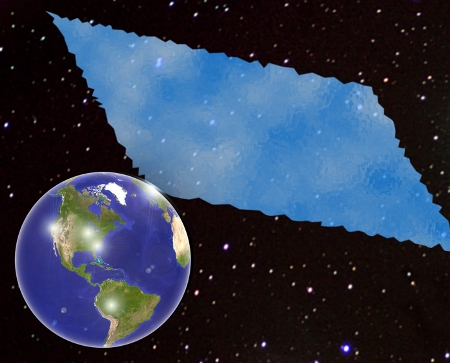Jan 7 2013
Researchers from Canada, California, and Poland have devised a straightforward way to test an intriguing idea about the nature of dark energy and dark matter. A global array of atomic magnetometers – small laboratory devices that can sense minute changes in magnetic fields – could signal when Earth passes through fractures in space known as domain walls. These structures could be the answer to the universe’s darkest mysteries.
 When Earth crosses a domain wall, the Global Network of Optical Magnetometers for Exotic Physics (GNOME) could detect the event using four magnetometers (Northern Hemisphere in this sketch) to determine the normal velocity of the wall and predict its passing at other locations. One or more remaining magnetometers would verify the prediction and the measurements.
When Earth crosses a domain wall, the Global Network of Optical Magnetometers for Exotic Physics (GNOME) could detect the event using four magnetometers (Northern Hemisphere in this sketch) to determine the normal velocity of the wall and predict its passing at other locations. One or more remaining magnetometers would verify the prediction and the measurements.
Dark energy opposes the mutual gravitational attraction of matter and causes the expansion of the universe to accelerate; it’s thought to account for three-quarters of the universe’s mass-energy. Another fifth is dark matter, sharing nothing with the remaining five percent of “ordinary” matter except gravitational attraction. There are plenty of theoretical ideas to explain dark matter and dark energy, but there’s little experimental evidence to help scientists choose among them.
An early candidate for both is a hypothetical particle called the axion. Arising from a field theory proposed in 1977 as the solution to quite a different problem in fundamental physics, axions were quickly recognized as possible constituents of dark matter. Soon after dark energy was discovered in 1998, theorists realized that axions might be the key to dark energy as well.
The field theory that gives rise to axion-like particles can also give rise to domain walls – boundaries between distinct regions of space with different properties, analogous to grain boundaries in crystalline alloys. As the universe expanded and cooled, a space-filling network of energy-storing domain walls may have formed, connecting large spatial domains of the same vacuum energy. If Earth crossed such a boundary, the properties of its atoms might be briefly affected. But what are the chances that that could happen? And if it did, how could it be detected?
Maxim Pospelov, a particle theorist at Canada’s University of Victoria and Perimeter Institute for Theoretical Physics in Waterloo, has an interest in such defects, and Dmitry Budker of Berkeley Lab’s Nuclear Science Division and UC Berkeley’s Department of Physics is a leader in constructing atomic magnetometers. They and their colleagues, Szymon Pustelny and Micah Ledbetter at UC Berkeley, Derek Jackson Kimball of Cal State University East Bay, and Wojciech Gawlik of the Jagiellonian University in Kraków, estimate that chances of encountering domain walls are good.
Although a single magnetometer would have no hope of distinguishing an exotic event like the passing of a domain wall from mundane sources of spurious noise, a domain wall could be unambiguously detected with five magnetometers. Four, widely spaced, could calculate the wall’s speed and direction and the fifth could check the prediction.
Budker and Ledbetter have built one of two magnetometers already in place in Berkeley, which measures weak external fields by seeing how they affect the nuclear spin orientation of a collection of atoms. Another placed in Kraków uses a different principle. Both are synchronized by GPS and act as a prototype for the proposed Global Network of Optical Magnetometers for Exotic Physics (GNOME).